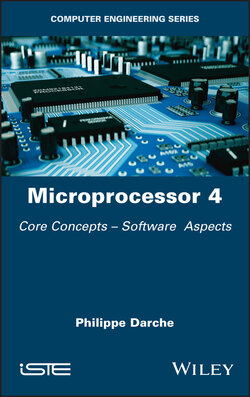Читать книгу Microprocessor 4 - Philippe Darche - Страница 10
Оглавление
Preface
Computer systems (hardware and software) are becoming increasingly complex, embedded and transparent. It therefore is becoming difficult to delve into basic concepts in order to fully understand how they work. In order to accomplish this, one approach is to take an interest in the history of the domain. A second way is to soak up technology by reading datasheets for electronic components and patents. Last but not least is reading research articles. I have tried to follow all three paths throughout the writing of this series of books, with the aim of explaining the hardware and software operations of the microprocessor, the modern and integrated form of the central unit.
About the book
This five-volume series deals with the general operating principles of the microprocessor. It focuses in particular on the first two generations of this programmable component, that is, those that handle integers in 4- and 8-bit formats. In adopting a historical angle of study, this deliberate decision allows us to return to its basic operation without the conceptual overload of current models. The more advanced concepts, such as the mechanisms of virtual memories and cache memory or the different forms of parallelism, will be detailed in a future book with the presentation of subsequent generations, that is, 16-, 32- and 64-bit systems.
The first volume addresses the field's introductory concepts. As in music theory, we cannot understand the advent of the microprocessor without talking about the history of computers and technologies, which is presented in the first chapter. The second chapter deals with storage, the second function of the computer present in the microprocessor. The concepts of computational models and computer architecture will be the subject of the final chapter.
The second volume is devoted to aspects of communication in digital systems from the point of view of buses. Their main characteristics are presented, as well as their communication, access arbitration, and transaction protocols, their interfaces and their electrical characteristics. A classification is proposed and the main buses are described.
The third volume deals with the hardware aspects of the microprocessor. It first details the component's external interface and then its internal organization. It then presents the various commercial generations and certain specific families such as the Digital Signal Processor (DSP) and the microcontroller. The volume ends with a presentation of the datasheet.
The fourth volume deals with the software aspects of this component. The main characteristics of the Instruction Set Architecture (ISA) of a generic component are detailed. We then study the two ways to alter the execution flow with both classic and interrupt function call mechanisms.
The final volume presents the hardware and software aspects of the development chain for a digital system as well as the architectures of the first microcomputers in the historical perspective.
Multi-level organization
This book gradually transitions from conceptual to physical implementation. Pedagogy was my main concern, without neglecting formal aspects. Reading can take place on several levels. Each reader will be presented with introductory information before being asked to understand more difficult topics. Knowledge, with a few exceptions, has been presented linearly and as comprehensively as possible. Concrete examples drawn from former and current technologies illustrate the theoretical concepts.
When necessary, exercises complete the learning process by examining certain mechanisms in more depth. Each volume ends with bibliographic references including research articles, works and patents at the origin of the concepts and more recent ones reflecting the state of the art. These references allow the reader to find additional and more theoretical information. There is also a list of acronyms used and an index covering the entire work.
This series of books on computer architecture is the fruit of over 30 years of travels in the electronic, microelectronic and computer worlds. I hope that it will provide you with sufficient knowledge, both practical and theoretical, to then specialize in one of these fields. I wish you a pleasant stroll through these different worlds.
IMPORTANT NOTES.– As this book presents an introduction to the field of microprocessors, references to components from all periods are cited, as well as references to computers from generations before this component appeared.
Original company names have been used, although some have merged. This will allow readers to find specification sheets and original documentation for the mentioned integrated circuits on the Internet and to study them in relation to this work.
The concepts presented are based on the concepts studied in selected earlier works (Darche 2000, 2002, 2003, 2004, 2012), which I recommend reading beforehand.
Philippe DARCHE
August 2020
